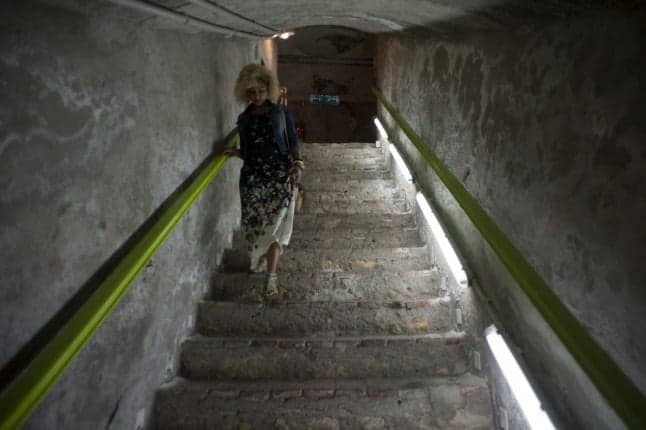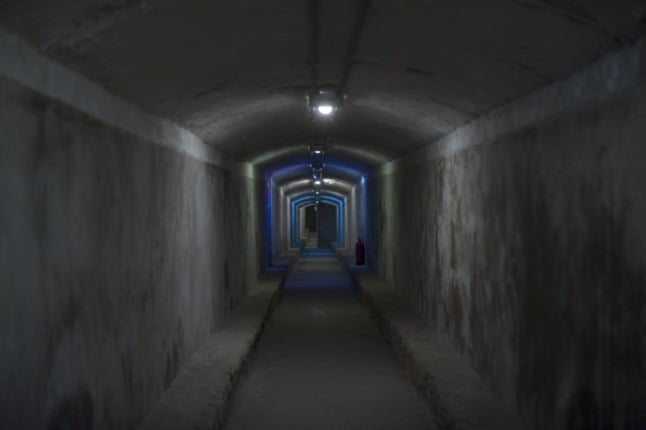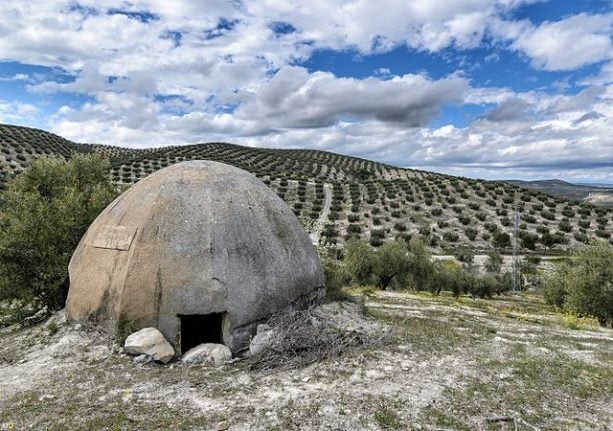Where are Spain's nuclear bunkers and bomb shelters?

It's probably something you've never thought of before, but in the (still) highly unlikely event of a nuclear or military attack on Spain, where can people go to protect themselves?
It may seem pretty dramatic to write about what one should do in the event of a (nuclear) attack in relatively peaceful Spain.
Spaniards even have a word for this kind of behaviour - catastrofista - meaning alarmist or pessimistic.
But if there ever was a suitable time to have some form of knowledge about refuge in times of war, now feels like the right time.
After all, with Russia's ongoing invasion of Ukraine and their recent takeover of a Ukrainian nuclear plant - not before setting it alight (the fire was extinguished fortunately) - in the back of many people's minds is what they should do if there were a nuclear war or catastrophe in Europe, or if Spain, as a member of Nato and the EU, could be at risk of attack from Putin's Russia.
The concept seems unfathomable in the 21st century and it's impossible to predict what will happen next, but it would be fair to say the risk of something like this happening has increased in the last ten days, however marginally.
"If you are outdoors when a detonation occurs take cover from the blast behind anything that might offer protection," reads the US government website Ready.gov about how to behave in the event of a nuclear explosion (needless to say, Spain's Moncloa has no such website).
"Lie face down to protect exposed skin from the heat and flying debris. After the shock wave passes, get inside the nearest, best shelter location for protection from potential fallout. You will have 10 minutes or more to find an adequate shelter.
"Be inside before the fallout arrives." Nuclear fallout is the residual radioactive material propelled into the upper atmosphere following a nuclear blast.
"The highest outdoor radiation levels from fallout occur immediately after the fallout arrives and then decrease with time."
"The best locations are underground and in the middle of larger buildings."
There is more advice on ready.gov but we're now going to focus on the locations in Spain that could offer the best shelter, whether it be from a bomb raid, or worse.
Underground metro networks
As has been evidenced in Ukraine in recent days, subways can double up as bomb shelters in the event of an attack.
Madrid, Barcelona, Valencia, Bilbao, Palma de Mallorca, Sevilla, Málaga and Granada all have metro networks which can act as an effective shelter for civilians in the events of a raid or other type of attack.
Cuatro Caminos station is the deepest in Madrid (45 metres underground), whereas in Barcelona it's El Coll-La Teixonera (74 metres underground).
Houses with bunkers
Although it must be said again that the possibility of nuclear war affecting Spain is incredibly low, having a nuclear bunker at home might now be on your list of priorities.
You aren’t the only one. Spanish home construction company ABQ claims to have put up over 400 alone in recent years, even before this latest Ukrainian invasion inspired fear and paranoia. Bunkeralia also recorded a spike in interest in their luxury bunkers at the start of the Covid-19 pandemic.
There has in fact been market demand for some years, and it seems rather unsurprising that the private home bunkers are generally built by wealthy homeowners on private property.
Prices vary according to size and other features, but according to ABQ, the most basic 50-square-meter bunker - able to shelter a maximum of 25 people for 15 days - costs a whopping €45,000, whereas the much bigger bunkers that look like luxury apartments go for at least €1 million.
La Moncloa, Madrid
Like all governments the world over, Spain’s official residence of the Prime Minister at La Moncloa in Madrid is well kitted out when it comes to surviving a nuclear holocaust.
La Moncloa has a basement bunker of 7,500 square meters, three-metre thick walls, an operating room, secret entrances and even a cemetery. There are also refrigerated areas with food, drink, and medicines to see out any prolonged fighting or radiation.
Almería
There are 67 entrances spread out across the Andalusian city of Almería to a network of air raid shelters some nine metres below the surface, extending around 4.5 kilometres (2.8 miles) underground.
Built during Spanish civil war times, they could fit 37,000 people, roughly three-quarters of the city's population at the time.
In 2006, Almería city councillor Miguel Cazorla pushed to have a one-kilometre stretch of the shelters restored and turned into a museum, which now welcomes thousands of visitors a year.

Lights illuminate an underground gallery of a Spanish civil war-era bomb shelter in Almería. (Photo by JORGE GUERRERO / AFP)
Parque del Capricho, Madrid
Also in Madrid, this 2,000 square-metre bunker is at 15 metres underground.
It is believed the Capricho bunker can withstand bombs of up to 100 kilos, and was known as Posición Jaca during the Spanish Civil War, when the bunker was used by the Republicans to defend Madrid from Nationalist besiegement.
When under attack, high-ranking Republicans sought refuge in the bunker, and although it is now covered in a thick layer of moss, around two-hundred people could take refuge there today if a nuclear bomb was ever used in Europe.
Barcelona
Perhaps you’ve already been to the Carmel base in Barcelona without even realising. Millions of tourists have been up there as it provides some of the best views of the city, and although it was an anti-aircraft base it is now unclear how prepared it is for action due to its tourist attraction role.
The Catalan capital is also home to hundreds of anti-aircraft shelters under the city, you can find out where here.

The Carmel bunkers are a viewpoint with some of the best views of Barcelona. Photos: Tibor Janosi Mozes/Pixabay, AFP
Torrejón de Ardoz Air Base
The Torrejón de Ardoz military air base, near Madrid, is home to Spain’s biggest bunker at over 10,000 square metres. It can house up to 600 people and can withstand the direct impact of powerful 2,000 kilo bomb.
The Canary Islands
The Atlantic archipelago, some 1,700 kilometres from the Iberian peninsula, could arguably one of the safest places to be if war were to break out in mainland Europe.
A series of military bunkers were also built in the Canaries during World War Two as part of various contingency invasion and defence plans. Fearing a British invasion of the Canaries and other surrounding islands as part of ‘Operation Pilgrim’, Spain fortified its defences on the island with the help of the Nazis, and supported them in their planned ‘Operation Felix’ invasion of Gibraltar to gain control of the strategically crucial Straight of Gibraltar.
Those that remain - particularly what are known as the ‘Pillboxes of Lanzarote’ - are thought to be in relatively good condition considering their age.
Other bunkers across Spain
The Spanish government doesn't have official data on the number of bunkers available to the general public across the country, but there are more than those listed above.
Córdoba province, Galicia, Extremadura, Murcia, Valencia and other regions have little-known air shelters and bunkers, many of them privately owned by individuals or businesses. If you wish to search for a bunker near you in Spain, it's worth remembering that the word for bunker in Spanish is the same - búnker.

A bunker in Albendín, Córdoba. Photo: Edmundo Sáez/Wikimedia (CC)
How does Spain compare?
Albania is home to the most underground bunkers in the world, with roughly half a million according to BBC data, built as a result of Cold War paranoia in the country under their communist leader Enver Hoxha.
In Switzerland all new constructions must include space for some kind of bunker by law, and in 2006 there were over 300,000 shelters with the capacity to house 114 percent of its citizens.
Sweden is also reported to have 65,000 fallout shelters across the country. According to Subterranean Britannica, there are 258 nuclear bunkers spread around the UK.
READ ALSO:
What are Switzerland’s nuclear bunkers and does each home need one?
Comments
See Also
It may seem pretty dramatic to write about what one should do in the event of a (nuclear) attack in relatively peaceful Spain.
Spaniards even have a word for this kind of behaviour - catastrofista - meaning alarmist or pessimistic.
But if there ever was a suitable time to have some form of knowledge about refuge in times of war, now feels like the right time.
After all, with Russia's ongoing invasion of Ukraine and their recent takeover of a Ukrainian nuclear plant - not before setting it alight (the fire was extinguished fortunately) - in the back of many people's minds is what they should do if there were a nuclear war or catastrophe in Europe, or if Spain, as a member of Nato and the EU, could be at risk of attack from Putin's Russia.
The concept seems unfathomable in the 21st century and it's impossible to predict what will happen next, but it would be fair to say the risk of something like this happening has increased in the last ten days, however marginally.
"If you are outdoors when a detonation occurs take cover from the blast behind anything that might offer protection," reads the US government website Ready.gov about how to behave in the event of a nuclear explosion (needless to say, Spain's Moncloa has no such website).
"Lie face down to protect exposed skin from the heat and flying debris. After the shock wave passes, get inside the nearest, best shelter location for protection from potential fallout. You will have 10 minutes or more to find an adequate shelter.
"Be inside before the fallout arrives." Nuclear fallout is the residual radioactive material propelled into the upper atmosphere following a nuclear blast.
"The highest outdoor radiation levels from fallout occur immediately after the fallout arrives and then decrease with time."
"The best locations are underground and in the middle of larger buildings."
There is more advice on ready.gov but we're now going to focus on the locations in Spain that could offer the best shelter, whether it be from a bomb raid, or worse.
Underground metro networks
As has been evidenced in Ukraine in recent days, subways can double up as bomb shelters in the event of an attack.
Madrid, Barcelona, Valencia, Bilbao, Palma de Mallorca, Sevilla, Málaga and Granada all have metro networks which can act as an effective shelter for civilians in the events of a raid or other type of attack.
Cuatro Caminos station is the deepest in Madrid (45 metres underground), whereas in Barcelona it's El Coll-La Teixonera (74 metres underground).
Houses with bunkers
Although it must be said again that the possibility of nuclear war affecting Spain is incredibly low, having a nuclear bunker at home might now be on your list of priorities.
You aren’t the only one. Spanish home construction company ABQ claims to have put up over 400 alone in recent years, even before this latest Ukrainian invasion inspired fear and paranoia. Bunkeralia also recorded a spike in interest in their luxury bunkers at the start of the Covid-19 pandemic.
There has in fact been market demand for some years, and it seems rather unsurprising that the private home bunkers are generally built by wealthy homeowners on private property.
Prices vary according to size and other features, but according to ABQ, the most basic 50-square-meter bunker - able to shelter a maximum of 25 people for 15 days - costs a whopping €45,000, whereas the much bigger bunkers that look like luxury apartments go for at least €1 million.
La Moncloa, Madrid
Like all governments the world over, Spain’s official residence of the Prime Minister at La Moncloa in Madrid is well kitted out when it comes to surviving a nuclear holocaust.
La Moncloa has a basement bunker of 7,500 square meters, three-metre thick walls, an operating room, secret entrances and even a cemetery. There are also refrigerated areas with food, drink, and medicines to see out any prolonged fighting or radiation.
Almería
There are 67 entrances spread out across the Andalusian city of Almería to a network of air raid shelters some nine metres below the surface, extending around 4.5 kilometres (2.8 miles) underground.
Built during Spanish civil war times, they could fit 37,000 people, roughly three-quarters of the city's population at the time.
In 2006, Almería city councillor Miguel Cazorla pushed to have a one-kilometre stretch of the shelters restored and turned into a museum, which now welcomes thousands of visitors a year.

Parque del Capricho, Madrid
Also in Madrid, this 2,000 square-metre bunker is at 15 metres underground.
It is believed the Capricho bunker can withstand bombs of up to 100 kilos, and was known as Posición Jaca during the Spanish Civil War, when the bunker was used by the Republicans to defend Madrid from Nationalist besiegement.
When under attack, high-ranking Republicans sought refuge in the bunker, and although it is now covered in a thick layer of moss, around two-hundred people could take refuge there today if a nuclear bomb was ever used in Europe.
Barcelona
Perhaps you’ve already been to the Carmel base in Barcelona without even realising. Millions of tourists have been up there as it provides some of the best views of the city, and although it was an anti-aircraft base it is now unclear how prepared it is for action due to its tourist attraction role.
The Catalan capital is also home to hundreds of anti-aircraft shelters under the city, you can find out where here.

Torrejón de Ardoz Air Base
The Torrejón de Ardoz military air base, near Madrid, is home to Spain’s biggest bunker at over 10,000 square metres. It can house up to 600 people and can withstand the direct impact of powerful 2,000 kilo bomb.
The Canary Islands
The Atlantic archipelago, some 1,700 kilometres from the Iberian peninsula, could arguably one of the safest places to be if war were to break out in mainland Europe.
A series of military bunkers were also built in the Canaries during World War Two as part of various contingency invasion and defence plans. Fearing a British invasion of the Canaries and other surrounding islands as part of ‘Operation Pilgrim’, Spain fortified its defences on the island with the help of the Nazis, and supported them in their planned ‘Operation Felix’ invasion of Gibraltar to gain control of the strategically crucial Straight of Gibraltar.
Those that remain - particularly what are known as the ‘Pillboxes of Lanzarote’ - are thought to be in relatively good condition considering their age.
Other bunkers across Spain
The Spanish government doesn't have official data on the number of bunkers available to the general public across the country, but there are more than those listed above.
Córdoba province, Galicia, Extremadura, Murcia, Valencia and other regions have little-known air shelters and bunkers, many of them privately owned by individuals or businesses. If you wish to search for a bunker near you in Spain, it's worth remembering that the word for bunker in Spanish is the same - búnker.

How does Spain compare?
Albania is home to the most underground bunkers in the world, with roughly half a million according to BBC data, built as a result of Cold War paranoia in the country under their communist leader Enver Hoxha.
In Switzerland all new constructions must include space for some kind of bunker by law, and in 2006 there were over 300,000 shelters with the capacity to house 114 percent of its citizens.
Sweden is also reported to have 65,000 fallout shelters across the country. According to Subterranean Britannica, there are 258 nuclear bunkers spread around the UK.
READ ALSO:
What are Switzerland’s nuclear bunkers and does each home need one?
Join the conversation in our comments section below. Share your own views and experience and if you have a question or suggestion for our journalists then email us at [email protected].
Please keep comments civil, constructive and on topic – and make sure to read our terms of use before getting involved.
Please log in here to leave a comment.